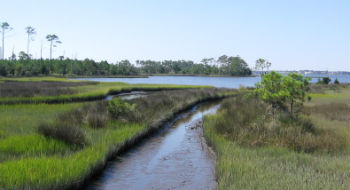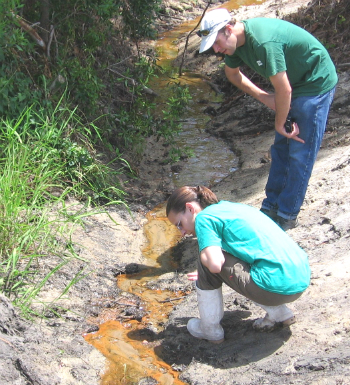 This is Dubling Creek, one of the four watersheds in the lower White Oak River, which the EPA considers “impaired.” It was one of the waterways that the N.C. Coastal Federation tested for bacteria levels in 2006. Now the federation hopes to reduce the volume of polluted stormwater runoff reaching the White Oak River by installing and monitoring best management practices. Photo: staff |
CEDAR POINT — Could a $6 piece of plastic make a significant difference in the health of one of North Carolina’s most scenic coastal rivers?
It just might, if enough people use the downspout extensions, according to Lauren Kolodij, the deputy director of the N.C. Coastal Federation, an environmental conservation group. If home and business owners combine that inexpensive solution to polluted stormwater pollution with other simple, low-cost best management practices, such as rain barrels and small rain gardens, there’s really no telling, yet, how much the White Oak River might benefit, she said.
Sponsor Spotlight
The N.C. Coastal Federation aims not only to encourage the use of these small-scale devices and plantings in and around the town of Cedar Point but also plans to measure their effects, as well as those of larger-scale efforts, thanks to a new, $272,000 project funded by the federal Environmental Protection Agency and by local matches and in-kind contributions,.
Studies by N.C. State University, Kolodij said, have shown that using downspout extensions, which direct rain from gutters to vegetated areas instead of onto driveways, patios and other hard surfaces, can reduce stormwater runoff from properties by as much as 90 percent.
According to Kolodij, bacteria-and-pollution-laden stormwater is by far the major culprit in the EPA’s designation of the White Oak as an impaired stream.
“What has happened over the years is that we have altered the landscape and modified the hydrology, and to clean up the river, we’ve got to get back as close as possible to where we were before we did that,” Kolodij said.
Sponsor Spotlight
Back in 2006, the federation undertook a major study of the bacterial pollution in the White Oak River. Almost two-thirds of the river’s oyster and clam beds are closed permanently to shellfishing or are closed temporarily after moderate rain because of dangerously high levels of bacteria in the water. The study found very high levels of fecal coliform bacteria in four watersheds in the lower river near Cedar Point. In the most extensive bacteria testing ever done on the river, more than 200 water samples were drawn from almost 70 scattered sites. Eighty-nine percent of the samples exceeded the federal health standard for shellfish waters. Of the 113 samples taken from the largest watershed, Boathouse Creek, all but three exceeded the standard.
 Volunteers prepare to draw a water sample from a small spring that flows to the White Oak River. Eighty-nine percent of the samples in this study had high levels of bacteria that exceeded the federal health standard for shellfish harvest. Photo: staff |
The study outlined a series of voluntary steps that could be taken to reduce the flow of stormwater into the river. They included modifying existing stormwater drainage ditches to allow more runoff to soak into the ground before reaching the river, educating people about the effects of stormwater and how to prevent their pets’ waste from contributing to bacteria pollution, and allowing developers to use more innovative techniques to control runoff.
After that study, Cedar Point partnered with the federation to create an extensive rain garden at the town hall, said Chris Seaberg, the town administrator. Also, follow-up studies showed not only that runoff decreased dramatically, but bacteria and other pollutants ceased making it into the underground aquifer.
“We’re very glad the federation has been able to get this new grant and we look forward to continuing to work with them,” Seaberg said. “We want to set up a time for the federation to make a presentation to our town board and our citizens.
“We know there’s a lot more that can be done, and that it needs to be a group effort, involving not just us and the town, but also the state Department of Transportation and DENR (state Department of Environment and Natural Resources),” Seaberg added. “We’re particularly interested in some of the things we know can be done at the grassroots-level in some of our neighborhoods, such as Marsh Harbor.”
Kolodij said it’s important work, and noted that the town has been an enthusiastic partner in the effort to improve water quality. Cedar Point has also encouraged low-impact development, or LID, by posting an LID manual, developed by the federation, on its website.
“We and the town are committed to reversing the trend of water quality degradation in the White Oak,” Kolodij said. “Through this project, we’ll expand on our collaborative efforts to reduce the volume and flow of stormwater being discharged into the river. Cumulatively, runoff discharges in the watershed are impairing more than 2,200 acres, or almost two-thirds of the designated shellfishing waters of the lower White Oak River.”
The goal of the new project, she said, is to work with the town, East Carolina University and a yet-to-be-selected local project team of committed experts to prioritize, locate, design, build and monitor a series of 12 stormwater reduction measures that will keep an estimated 55,000 gallons of runoff from reaching the river.
Lexia Weaver, a federation coastal scientist who will be working on the project, said the grant was large enough to enable the partners involved to do some things that will make a real difference, and said she’s glad ECU has signed on to do the monitoring.
While reducing the volume of stormwater runoff is important, so is the monitoring by ECU, Kolodij said. “Without monitoring before and after the project – determining the volumes of runoff before and after the changes – you don’t really quantify the impacts,” she said. “It’s important to see what works best and to be able to tell people what they can do to have the most impact.
 Lauren Kolodij |
“We’ll showcase successes to local residents and the media,” she added. “This promotion will focus on the importance of stormwater reduction on a lot-by-lot basis within the watershed to ultimately achieve stormwater volume reduction and water quality goals.”
None of this needs be hard or expensive for property owners, Kolodij emphasized. For example, N.C. State promotes what it calls a “10-10-10” rain garden plan that’s said to be very effective. You simply measure the roof of your structure, take 10 percent of that, dig a hole that size 10 feet from the structure, 10-inches deep, put in the right plants and maintain the result.
“We could, of course, spend millions in all of our watersheds,” Kolodij said. “But we also know that we can make a big difference by doing much smaller things, by working in neighborhoods and by educating people about what they can do.”
Before starting on the project, the federation and ECU plan to meet with potential partners – interested people, town officials and others – and hold a community workshop to get ideas and suggestions. The original projectreport had a long list of best management practices and suggestions. “Part of what we want to do is take another look at those and see how we can implement them,” She said.
The river and its tributaries are still fished and increasingly used by kayakers and canoeists. It runs 48 miles, from Hofmann Forest in Jones County, and winds its way, as old rivers do, through many sleepy towns in Jones, Carteret and Onslow counties before reaching the ocean.
“We have to be able to show that water quality improves,” Weaver said. “I’m confident we’ll be able to do that.”







